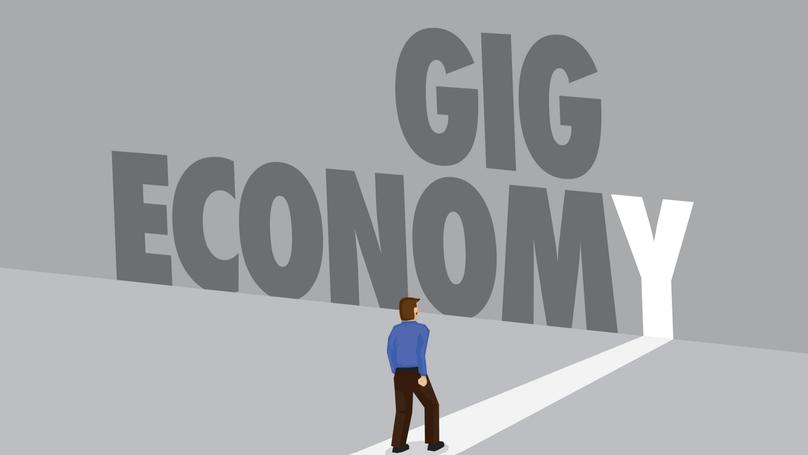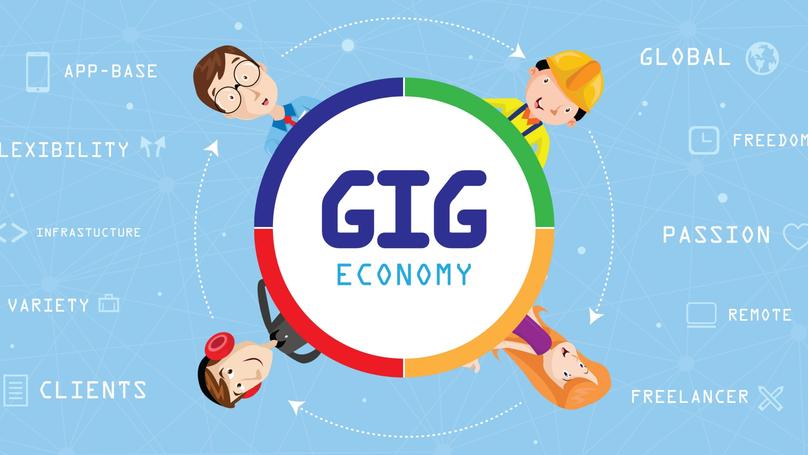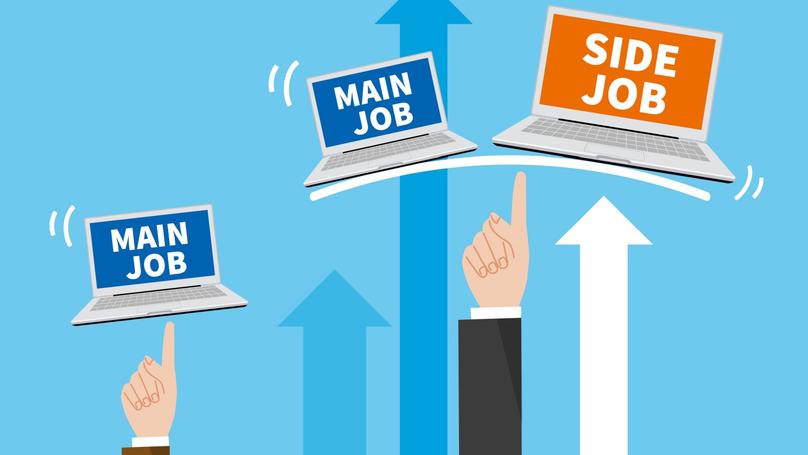Gig Economy

What is The Gig Economy?
The gig economy is a business model where businesses rely primarily on freelancers or outsourced workers rather than maintaining permanent staff tied to employment contracts. Consequently, this model does not involve traditional office employment, and any money paid will depend on the results, whether completing a project or providing a one-time service.
The definition of the term "gig" emerged in the 1920s as part of the musical language at the time; jazz musicians generally used it to define one-time paid performances at clubs or social gatherings. It entered the business realm in the 2000s, coinciding with the internet's emergence, which enabled the rise of digital professions and remote work. The gig economy initially flourished in IT, where programmers, testers, and analysts led the way by undertaking projects for various international firms while juggling multiple assignments. Eventually, various professions adopted the gig economy jobs, including designers, translators, copywriters, accountants, lawyers, tutors, and psychologists. So, technology has helped the gig economy grow.
Companies frequently utilize specialized online platforms and service exchanges to capitalize on the gig economy. These services enable businesses to examine candidate profiles and hire temporary workers when needed. However, some organizations integrate the gig model directly into their operations, positioning it at the heart of their profitability. A notable example includes ride-hailing services or taxi aggregators, where workers are engaged temporarily without traditional employment contracts. Instead, they enter into mutually beneficial, short-term agreements. In these scenarios, service providers earn their money directly from customers rather than through the company, highlighting an alternative aspect of the gig economy.
Gig Economy Pros and Cons

The gig economy primarily benefits people who can work remotely, especially those on a project basis or in the service sector who can operate as freelancers. From a corporate standpoint, the gig economy benefits businesses with a limited range of ongoing tasks and procedures. In these circumstances, a small team can manage essential operations while depending on freelancers for extra support. Additionally, companies can utilise the gig economy to address temporary workforce needs, such as outsourcing annual accounting tasks.
Either way, the gig economy has advantages and disadvantages. Among the primary benefits for companies are:
-
Cost savings. The gig economy allows businesses to bypass tedious bureaucracy and avoid the costs associated with increasing their workforce by relying on freelancers. Companies do not need to supervise working situations, offer social benefits such as insurance for sick leave, or rent larger office spaces when employing freelance workers. Likewise, businesses have the flexibility to terminate freelance contracts at any time, without facing administrative hurdles.
-
Diversity in the workforce enhances a company's ability to identify the ideal employee when faced with new challenges quickly. This helps the company usually bypass the lengthy methods of job postings and interviews in a matter of hours, or at most, a couple of days. Freelance platforms improve the hiring process, offering greater efficiency for both employers and job seekers.
-
Adapting to gig economy trends. In the wake of the COVID-19 pandemic, the job market has placed increasing emphasis on flexibility and remote work options. More independent and convenient work hours, together with self-managed scheduling, enhance productivity by reducing stress and absenteeism while also improving motivation.
Freelance work offers similar benefits from the perspective of employees. Remote work or a flexible schedule provides more opportunities for travel, family time, and personal development. Freelancers enhance their skills while juggling multiple projects across various companies, significantly boosting their overall income.
However, the gig economy also presents certain drawbacks, including:
-
Employee engagement often falls short. Individual motivations play a key role, as freelancers generally contribute less to a company's growth and success compared to full-time employees. Their temporary roles, which can end unexpectedly, often lead freelancers to avoid closely monitoring their contributions or feeling a strong sense of accountability towards the organization's goals.
-
Intense rivalry that exists among freelancers. On every freelance platform, you'll encounter hundreds of candidates showcasing various credentials and backgrounds, making it essential to attract a company's attention. This competitive landscape often results in reduced rates and lower earnings for workers due to the surplus of offers compared to the actual demand.
-
Lack of benefits. As previously noted, freelancers do not have access to paid sick leave or health insurance. In some cases, they may find it difficult to afford falling ill due to tight project deadlines or expiring contracts with companies.
-
Isolation. This presents a challenge for both employees and companies. It manifests as a lack of in-person interaction, leading to feelings of isolation from colleagues and management. While remote work may not suit everyone, it complicates the monitoring and assessment of work activities for businesses, often relying solely on measurable outcomes.
Examples of The Gig Economy

Most modern companies utilise the gig economy, especially in areas such as:
-
Food delivery and courier services. Take, for example, apps like Uber Eats or Deliveroo, where you can place an order from your phone anytime, and it will be prepared and delivered to you in the shortest possible time. Therefore, the platform connects both restaurants and delivery workers. The same applies to supermarkets and marketplaces.
-
Transportation and logistics. Although large businesses may have the resources to create transportation divisions, most rely on independent logistics providers for material delivery or warehouse rentals. Small companies often use third-party courier services to fulfil customer orders, mirroring the model of taxi services.
-
Hospitality companies. Like Airbnb, it connects hotels with vacation destinations and travellers, facilitating seamless communication and payments. It's worth noting that most gig economy companies operate as intermediaries within the service industry.
-
Online education. Numerous educational platforms, especially Lectera, depend on experts and educators for course development. Some professionals partner with these websites for a one-time project to create unique programs, while others consistently contribute to certain providers instead of becoming full-time employees.
-
Accounting and marketing. While large companies generally need payment solutions, many do not require continuous financial documentation or supervision. Instead, numerous companies prefer to collect receipts over a few months, which they then submit to a professional who handles tax filings and summaries. Likewise, in marketing, there are specialized firms that execute targeted advertising for both businesses and individuals. These companies professionally manage advertising setups, produce videos, and temporarily handle promotional tasks while working with multiple clients simultaneously.
Today, the gig economy extends to healthcare, exemplified by the Nomad Health platform. This website connects freelance doctors and nurses with hospitals requiring extra personnel during crises, sick leaves, or vacations of their permanent staff, an essential service for emergency help and saving lives. Gig economy companies include Fiverr, which enables businesses across various sectors to discover skilled freelancers, and Care, which simplifies care for older people and children by uniting public funding, freelancers, and those who need support.
Gig Economy Challenges

Working in the gig economy has downsides of working in the gig economy, not necessarily because of particular disadvantages, but because of the challenges a company adopting this model must tackle independently. These challenges also impact the broader job market and various private sectors.
1. Lack of skilled, permanent staff.
However, a company cannot solely rely on freelance workers, particularly if it isn't an intermediary and produces its goods or services. As more workers opt for temporary or part-time remote jobs, 68% of medium-sized businesses struggle to find permanent staff. This raises demand for full-time employees and intensifies competition among businesses, which must also provide more appealing social packages, benefits, and incentives to recruit the professionals they need. When a permanent workforce is essential, this personnel shortage can jeopardise the company's stability and disrupt operational consistency.
2. Quickly filling shifts and resolving scheduling gaps between hires
In contrast to permanent staff, who consistently offer reliable resources and personnel, freelance workers can be more challenging to manage and do not provide seamless replacements. If a freelancer becomes ill, an immediate substitute might not be available, potentially affecting productivity and causing customer dissatisfaction. Likewise, part-time freelancers may find it challenging to coordinate their availability effectively without careful scheduling.
Consider developing a specialized workforce database or joining a platform facilitating swift replacement searches to address this challenge. Effective communication with freelancers is essential; encourage them to disclose their availability, gauge their response times to urgent requests, and review their approaches for managing critical scenarios in advance. Additionally, leveraging business statistics can help predict demand fluctuations, enabling you to organise shifts better and allocate additional resources based on these statistics.
3. Monitoring employee performance
One of the peculiarities of the gig economy is that freelancers are assessed by their final results, rather than by KPIs or daily productivity metrics. This method is excellent for businesses that focus on results and are less concerned about the specific timing or location of work. However, it may pose challenges for companies that prefer stringent oversight of their operations. This system also carries risks, such as missed deadlines or discrepancies between the completed work and the original requirements. Freelancers maintain independence from the company in every aspect, leaving the company reliant on their timely completion of the assigned global task.
Using specialized software for automated planning can enable passive monitoring of work progress while ensuring that commitments are honoured. The gig economy often discourages direct tracking of employee performance, as this is viewed as taboo due to the absence of direct relations with freelance workers. Nevertheless, implementing a cloud-based planning service or a mind-mapping tool with freelancers can help overcome time management issues and improve task scheduling, thereby alleviating stress.
4. Engagement and retention of employees
Employee retention poses a challenge for 90% of companies, particularly in the gig economy, where the means to cultivate a corporate culture, promote team cohesion, provide support, and create training systems are limited elements typically associated with traditional recruitment practices. While not all companies prefer to replace freelancers constantly, many opt for longer collaborations that can last for years. However, this preference can lead to increased staff turnover and decreased retention. Freelancers, lacking deep connections to a single company, tend to be more vulnerable to changes in motivation and interests. This flexibility allows them to easily shift between different activities and tasks, facilitating transitions from one organization to another.
The solution to this challenge is to implement personalized systems. This entails creating motivation and incentive programs, fostering transparent communication between freelancers and management, and granting certain rights and benefits on par with full-time employees, such as access to corporate training and career development opportunities. Although the gig economy model often downplays these factors, combining them provides the flexibility of freelance work and traditional employment. This strategy enables freelancers to maintain their independence while working on a contractual basis, whilst receiving the advantages comparable to those of regular employees, features that competing companies might not offer.
5. Adherence to regulations and legal intricacies
Unlike employment or project-based agreements, the conventional employment contract is well recognised and frequently utilised in work relationships. When using specialised platforms to hire workers, examining their regulations in advance is vital since contract signing is typically automated and embedded within the website's features. It's crucial to recognise the different rules in various areas, especially regarding the implications of early contract termination. This awareness can help you avoid conflicts with freelance workers and ensure both parties fulfil their responsibilities. Additionally, the gig economy allows businesses to establish a unique status apart from traditional employers. For example, Uber made a successful argument in a British court a few years back that it is not a transportation company but an intermediary offering information services.
Impact of The Gig Economy

A 2023 research revealed that about 15% of freelancers are from Generation Z, 45% are Millennials, 27% are part of Generation X, and just 9% are Baby Boomers. Simultaneously, The involvement of younger generations in the gig economy is steadily rising in the gig economy as they grow older and new digital job opportunities arise, especially with the surge in online content creation and the increasing impact of social media.
According to Upwork's 2022 Freelance Outlook Report, the percentage of freelancers with higher education is consistently climbing, now around 26%. Understanding gender distribution in the gig economy is challenging. Some experts argue that men prefer full-time, permanent positions, whereas women often gravitate towards part-time or freelance work, typically seeking additional income, particularly during maternity leave. Regarding racial representation, the gig economy reflects the overall job market, exhibiting equal proportions.
Since the gig economy operates across many distinct and non-overlapping areas, it is impossible to determine an exact average salary for employees working in the gig model. Likewise, many workers engage in various activities and types of employment, belonging to multiple fields simultaneously, providing flexibility in hours and part-time work. Additionally, compensation structures vary by area; for instance, the food delivery sector employs a system of rates and percentages, while marketing outsourcing companies operate on a fixed payment per project. As a result, no definitive list of "best gig economy jobs" exists, as income and working conditions depend heavily on the traditional job market and the particular organization or intermediary platform's structure.
Interestingly, 44% of freelance workers reported earning more in their freelance roles than with a permanent employer. They also describe their current workload as lighter than traditional full-time employment.
Future of The Gig Economy

As mentioned earlier, the coronavirus pandemic significantly increased the demand for the gig economy, which started in the 2000s. Only a few years have passed since the pandemic ended, and it is too soon to foresee a decline or end of the gig economy. Conversely, we can anticipate the expansion of the gig economy growth, as it is strongly connected to technological advancements that create new digital professions and broaden the industry. Additionally, the digital transformation of traditional job markets and various areas of life is occurring gradually, spanning higher education, universities, healthcare services, financial firms, and the banking sector. In this regard, the number of online professions will increase, consequently expanding the gig economy.
Traditional businesses, especially small and medium-sized ones, are increasingly realising the benefits of the gig economy. This model minimises personnel, equipment, and rent expenses, along with time savings. Simultaneously, the gig economy enhances business flexibility and competitiveness, particularly through hybrid employment models that integrate both permanent staff and gig economy workers as needed, allowing for improved business strategy and team management.
Conclusion
The gig economy is undeniably a contemporary employment model, catering to the fast-paced lifestyle and flexibility that modern workers demand. However, from a social perspective, it resembles 19th-century labor practices, when home-based workers thrived, trade unions were absent, and employees had to independently navigate the lack of sick leave while covering social expenses, such as pensions. It restricts career advancement, making this model unsuitable for those aspiring to management roles or a long-term career in a single field or company. However, this is an unavoidable trade-off, allowing you to gain a more adaptable work schedule and associated gig economy opportunities, which everyone chooses based on their employment type.























